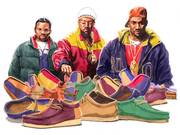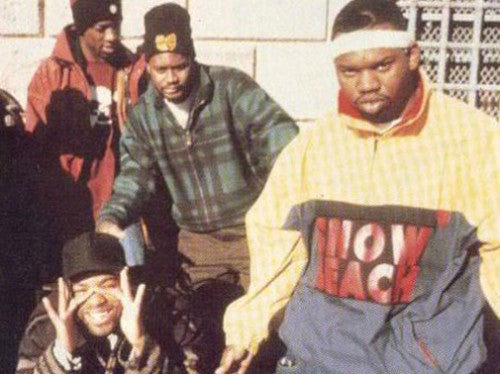To celebrate their upcoming collaboration with Clarks Originals, and 25 years of their debut album Enter The Wu-Tang (36 Chambers), we delve deep into the style legacy of the legendary East Coast collective to find out how they redefined hip-hop style forever.

Think of the ‘90s and you’re bound to think of the Wu-Tang Clan. The group came to rule the decade, stealing the limelight from the then-dominant West Coast scene. And they defined an era of hip-hop that featured crate-digger sampling, pop-culture referencing, and a never-before-seen reverence for good apparel. Wu-Tang changed the game in many respects, but they also changed the way rappers utilised style as part of their identity and they were arguably flag-bearers of the sort of product placement you see on every celebrity today, regardless of how close to the A-list they may sit.
Wu-Tang Clan were one of the first hip-hop collectives to actually care about labels and with a back catalogue of tracks that both precisely and meticulously reference numerous aspects of pop culture, the fashion world was continually touched upon. Whilst dissecting a two-and-a-half decade’s worth of pure steez is nigh on impossible, here we explore some of the fundamental aspects to the Clan’s look.


CLARKS, WALLABEES
Wu-Tang held the Wallabee in high esteem but from the outset, it was always Ghostface Killah that was a figurehead for the silhouette. Such was Ghostface’s love for the shoe that he went on to release a compilation of b-sides and remixes titled The Wallabee Champ, as well as appearing on the cover of his 1996 album Ironman, alongside Raekwon and Cappadonna holding a selection of two-tone custom Wu-Wear collab Wallabees. But it wasn't just Ghostface, the shoe appears again on Raekwon's 1995 solo album Only Built 4 Cuban Linx..., rapped about on the track Incarcerated Scarfaces.“You’ll feel the free spirit of the gull in every step you take in WALLABEES…” ran early American print adverts for the iconic silhouette. “…The combination of moccasin construction and thick crepe soles make WALLABEES one of the most comfortable shoes in the world.” Clark’s signature crepe-soled moccasin had a history stretching back to the late ‘60s, originally being named The Grasshopper, and had grown in popularity in both Europe and America over the years to form a solid part of the Clarks Originals line. But the shoe found unlikely fame in a handful of circles the world over, Jamaica’s roots reggae Rockers being one. With such popularity, the shoe inevitably leaked into the style book of East Coast hip-hop’s growing stars, but nowhere was this championed more than by the Wu-Tang Clan.To celebrate 25 years of the group’s debut, Enter The Wu-Tang (36 Chambers), Clarks Originals have teamed up with Wu Wear on a capsule collection of Wallabees in three exclusive colourways, with custom Wu Wear detailing.


CHAMPION, OVERSIZED
The notion of East Coast rappers wearing massively oversized clothing was distinctly anti-fashion, and this sense of rebellion underpinned the trend we readily associate with the genre. Prevailing mainstream style in the ‘90s tended towards wearing fitted attire but hip-hop, being much more part of the underground and wanting to maintain its own identity, opted for the opposite. Rappers and hip-hop kids alike began buying clothes in bigger sizes to eschew the prevailing mainstream trend. Brands that were aligned with the community soon began to cotton on and started producing deliberately baggy and oversized apparel in order to greater appeal to their burgeoning hip-hop fanbase.One of a number of brands Wu-Tang adorned in all its oversized glory was Champion. Already an American staple, having been founded in 1919 as the ‘Knickerbocker Knitting Company’, the brand was somewhat a mainstay amongst blue-collar workers wanting durable work attire and college athletes wanting apparel suitable for the cold. But in the ‘90s specifically, Champion was the king amongst all subcultures and communities, from the average college jocks to the hardcore punk scene. In that respect, it’s unsurprising that the brand made significant in-roads into the hip-hop scene, albeit in a more oversized manner than most others. Across numerous Wu-Tang photoshoots, both solo and group, the signature embroidered ‘C’ can be spotted. And on 7th Chamber from the group’s debut, Raekwon infamously spits “Champion gear that I rock, you get your boots knocked / Then attack you like a pit that lock shit down”. In essence, Champion had been with the Clan right from the start. Good thing the Reverse Weave doesn’t shrink…
TO ENRICH

TIMBERLAND
6-INCH BOOT
Timberland’s classic workwear boots were also synonymous with the hip-hop community owing to affordability. They were worn, and sang about, by pretty much everyone in the Clan, and were also notably worn by rap duos Mobb Deep and Smif-n-Wessun. Raekwon famously referred to them as "the boots that paved the way".

CHINESE MARTIAL ARTS
SHAOLIN & WU TANG
Wudang Quan is a class of Chinese martial arts, commonly referred to as Wu Tang. It was popularised to the American audience in the 1983 Hong Kong martial arts film Shaolin and Wu Tang, which depicted the rivalry between the two martial arts schools. Apart from inspiring the group’s name, Wu-Tang sampled audio from the film in their 1993 36 Chambers debut.

RALPH LAUREN
SNOW BEACH
One of the defining Wu-Tang pieces, the 1992 Ralph Lauren Snow Beach pullover has been desperately sought after by so-called ‘Lo-Heads’ for years. Raekown is said to have found the piece at Abraham & Straus, a clothing store in downtown Brooklyn, on the day of a photoshoot. Buying the only XXL the store had, in an interview for Complex in 2005 he said “I felt like it was one of a kind because it seemed like this was the only jacket in my size waiting for me.”

TOMMY HILFIGER
NEW YORK HIP-HOP
Conversely, whilst the New York hip-hop community appropriated POLO against Ralph Lauren’s wishes, owing to him not wanting to be associated with them, Tommy Hilfiger took note. He welcomed the community with open arms and at one point the brand ended up being modelled by Method Man and Aaliyah. Marketing was targeted to the point that Tommy Hilfiger stores would carry completely different lines based on the area in which they resided, in order to appeal to their vastly different demographics.
26 YEARS OF 36 CHAMBERS
Wu-Tang came to define an era of hip-hop whilst introducing it to the mainstream. An essential part of the ‘90s zeitgeist, they presented the underground to a global audience that would never have otherwise experienced it. Their dominance in the genre is admirable, and it’s safe to say hip-hop may never have become so prominent had it not been for the Clan. Far from rapping exclusively about gang violence or the struggles of making it, Wu-Tang infused their tracks with all manner of references which showed the world that a group of kids from the inner city could actually be switched on to wider culture.
We all know the riffs and the samples even to this day, and it’s no real ‘throwback’ to hear any number of the old tracks or albums. They’re still current. Pretty much every member of the Clan has gone on to successfully release solo as well as collaborate with a whole host of major players from the hip-hop world, and to this day Wu-Tang still release under the original line-up, minus Ol’ Dirty Bastard who died in 2004. There’s definitely a degree of truth, in that sense, to the second album’s title; Wu-Tang forever. The biggest legacy of all is that the legacy lives on…

